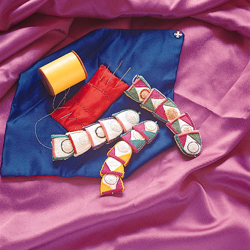|
 Sujech'ion
is a traditional wind ensemble in which the p'iri (bamboo flute) and taegum
(large transverse bamboo flute) are played in a long, revolving rhythm.
This ensemble is thought to have been in existence for several thousand
years. As a highly refined musical form, it exemplifies the uninterrupted,
continuous character of traditional Korean music. Fluid yet full of strength,
sober yet vibrant, Sujech'aon reminds one of a long, broad river. Foreigners
who hear this music for the first time often describe it as a "heavenly
sound" or "divine revelation." Indeed, this natural-sounding
music seems to echo forth from the distant past. Sujech'ion
is a traditional wind ensemble in which the p'iri (bamboo flute) and taegum
(large transverse bamboo flute) are played in a long, revolving rhythm.
This ensemble is thought to have been in existence for several thousand
years. As a highly refined musical form, it exemplifies the uninterrupted,
continuous character of traditional Korean music. Fluid yet full of strength,
sober yet vibrant, Sujech'aon reminds one of a long, broad river. Foreigners
who hear this music for the first time often describe it as a "heavenly
sound" or "divine revelation." Indeed, this natural-sounding
music seems to echo forth from the distant past.
Derived from
Buddhist music, Yongsan hoesang has now become purely instrumental. This
suite, consisting of nine pieces, can be played in its entirety or several
pieces can be performed separately. In terms of instrumentation, it can
be performed either as a solo, string ensemble or wind ensemble. The slow
tempo of the initial pieces creates a calm, sedate atmosphere which gradually
gives way to a quicker tempo and more lively feeling. As one of the most
common musical styles seen at traditional concerts, this musical form
is used for solos performed by a number of instruments and ensembles.
Yomillak,
created by King Sejong, was originally an elaborate musical performance
that combined singing and dance, but the dance and vocal forms gradually
fell into decline and it is thus performed only as an instrumental ensemble
piece today.
During its
development, Yomillak spawned a number of variants such as the Yomillang
Nyong, Yomillang Man and Haeryong. Such variants were also seen in other
traditional forms-an indication of the conservative character of the Korean
people and their respect for tradition. Particularly in Chong-ak music,
musicians traditionally would not dare to create a completely new form.
As a result, a limited repertoire was repeated for centuries, gradually
changing over time so as to give birth to new variations.
There are
three forms of traditional vocal performances in Korea: shijo, kasa and
kagok. In the shijo, or shijo ch'ang, a standardized three-lined poem
is sung to a fixed melody. The shijo ch'ang was previously a very popular
form. With its slow tempo and calm feeling, it appeals to common people
as elegant music that is easy to sing.
Kasa music,
on the other hand, is sung in a spirited prose style. The length of each
song is not fixed, and the main emphasis is on the literary content of
the piece rather than its melody. As a result, this musical form tends
to be simple and pure. At present, twelve traditional kasa compositions
are extant.
Among the
Chong-ak vocal styles, kagok is the most developed and requires the greatest
amount of technical ability. Kagok use the three-line, forty-five character
form of Shijo poetry. However, kagok, unlike shijo ch'ang, are sung in
precisely divided movements with a minor wind accompaniment. More than
twenty traditional kagok pieces still exist and these have diverse melodies
and themes. Taken as a whole, kagok has a sober yet leisurely, profound
atmosphere. Expressed in visual terms, kasa music can be compared to the
simple purity of Choson-era white-glaze pottery while kagok music embodies
the profound, contemplative quality of Koryo celadon.
|
![]()
![]() Korean Ritual Music 03
Korean Ritual Music 03